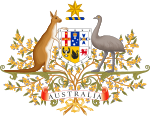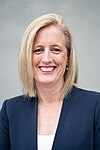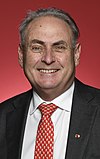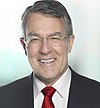 The Cabinet Room in Parliament House The Cabinet Room in Parliament House | |
 Commonwealth Coat of Arms Commonwealth Coat of Arms | |
| Formation | 1 January 1901; 124 years ago (1901-01-01) |
|---|---|
| Legal status | By convention |
| Purpose | Chief decision-making body of the Australian Government |
| Location |
|
| Prime Minister | Anthony Albanese |
| Current Cabinet | Albanese Ministry (since 1 June 2022) |
| Membership | 23 Cabinet ministers (maximum of 30 by legislation) |
| Website | www |
| This article is part of a series on the |
| Politics of Australia |
|---|
 |
| Constitution |
| Monarchy |
Executive
|
Legislature
|
|
Judiciary
|
Elections
|
|
States and territories
|
| Local government |
|
Foreign relations
|
| Ideologies |
|
|
The Cabinet of Australia, also known as the Federal Cabinet, is the chief decision-making body of the Australian government. The Cabinet is selected by the prime minister and is composed of senior government ministers who administer the executive departments and ministries of the federal government.
Ministers are appointed by the governor-general, on the advice of the prime minister, who is the leader of the Cabinet. Cabinet meetings are strictly private and occur once a week where vital issues are discussed and policy formulated. There are several Cabinet committees focused on governance and specific policy issues, with administrative support provided by the Department of the Prime Minister and Cabinet. The outer ministry consists of junior ministers outside of Cabinet. There are also a number of assistant ministers (designated as parliamentary secretaries under the Ministers of State Act 1952), responsible for a specific policy area and reporting directly to a senior Cabinet minister of their portfolio. The Cabinet, the outer ministry, and the assistant ministers collectively form the full Commonwealth ministry of the government of the day. Officials and advisors are not allowed to attend Cabinet, with only Cabinet ministers and the three official note-takers that produce Cabinet minutes able to be present during deliberations.
The Cabinet is a product of convention and practice. There is no reference to the Cabinet in the Australian Constitution and its establishment and procedures are not the subject of any legislation. The prime minister of the day determines the shape, structure and operation of the Cabinet and its Committees.
Decisions of Cabinet (formally known as Cabinet minutes) do not in and of themselves have legal force, requiring the endorsement from individual ministers, holders of statutory office, Parliament or the governor-general as advised by the non-deliberative Federal Executive Council—the highest formal executive body mentioned in the Constitution. In practice, the Federal Executive Council meets solely to endorse and give legal force to decisions already made by the Cabinet.
History
Until 1956 the Cabinet comprised all ministers. The growth of the ministry in the 1940s and 1950s made this increasingly impractical, and in 1956 Liberal Prime Minister Robert Menzies created a two-tier ministry, with only senior ministers being members of the Cabinet, while the other ministers are in the outer ministry. This practice has been continued by all governments since, with the exception of the Whitlam government.
When the non-Labor parties have been in power, the prime minister has advised the governor-general on all Cabinet and ministerial appointments at his own discretion, although in practice he consults with senior colleagues in making appointments. When the Liberal Party and its predecessors (the Nationalist Party and the United Australia Party) have been in coalition with the National Party (or its predecessor the Country Party), the leader of the junior Coalition party has had the right to nominate his party's members of the Coalition ministry, and to be consulted by the prime minister on the allocation of their portfolios.
When Labor first held office under Chris Watson, Watson assumed the right to choose members of his cabinet. In 1907, however, the party decided that future Labor cabinets would be elected by the members of the Parliamentary Labor Party (the Caucus), with the prime minister retaining the right to allocate portfolios. This practice was followed until 2007. Between 1907 and 2007, Labor prime ministers exercised a predominant influence over who was elected to Labor ministries, although the leaders of the party factions also exercised considerable influence. However, in 2007 Prime Minister Kevin Rudd, assumed the power to choose the ministry alone. Later, the caucus regained this power in 2013. According to reporting by the Sydney Morning Herald, ministerial positions are allocated by the Left and Right factions proportionally according to their representation in the Parliament.
Under two-tier ministerial arrangements introduced in 1987, each senior or portfolio minister was a member of the Cabinet. In 1996 this was modified by the Howard government, whereby two portfolio ministers, one being the attorney-general, were not members of Cabinet, and one portfolio had two Cabinet ministers. In subsequent Howard ministries, and the 2007 Rudd Labor ministry, all portfolio ministers were in the Cabinet.
Composition
Members of both the House of Representatives and Senate are eligible to serve as ministers and parliamentary secretaries. A minister does not have to be a member of either house, but section 64 of the Constitution requires the minister to become a member within three months. The prime minister and treasurer are traditionally members of the House of Representatives, but the Constitution does not have such a requirement. As amended in 1987, the Minister of State Act 1952 permits up to 30 ministers. As members of one house cannot speak in the other, ministers in each house serve as representatives of colleagues in the other for answering questions and other procedures.
As of September 2023 every government since Federation has had senators serve as ministers. The Senate typically provides one-quarter to one-third of the ministry. Some former senators and others have proposed that senators should not be eligible to serve as ministers, stating that doing so is inappropriate for members of a chamber that act as the states' house and a house of review and because governments are only responsible to the House of Representatives. John Uhr and Senator Baden Teague state that an advantage of senators serving in ministries is that the Senate can compel them to answer questions about the government.
Since the introduction of the two-tier ministry, meetings of Cabinet are attended by members only, although other ministers may attend if an area of their portfolio is on the agenda. Cabinet meetings are chaired by the prime minister, and a senior public servant is present to write the minutes and record decisions.
Since 1942, every member of the Cabinet has been a member of the Australian Labor Party, the Liberal Party of Australia, or the National Party of Australia.
Prime minister
The prime minister is responsible for the membership of the Cabinet, determines and regulates all Cabinet arrangements for the government and is the final arbiter of Cabinet procedures. As chair of the cabinet, the Prime minister sets the Cabinet’s agenda and determines when and where meetings take place. The Prime minister leads and guides discussion to achieve a collective response; however where a collective decision is not possible, the prime minister’s view is authoritative.
Principles of operation
The Australian Cabinet follows the traditions of the British parliamentary cabinet system. This entails collective decision-making and responsibility, Cabinet solidarity and confidentiality.
Collective decision-making and responsibility
Main article: Cabinet collective responsibilityThe role of collective decision-making reflects the parliamentary tradition that the confidence given to governments by the House of Representatives is collective, rather than towards individual ministers. Similarly, the governor-general, in acting on ministerial advice, needs to be confident that they only give effect to government policy. In practice this means that a decision of the Cabinet is binding on all members of the government, regardless of whether they were present when the decision was taken or their personal views. Issues are debated within the confidential setting of Cabinet meetings so that some form of consensus can be summarised by the prime minister, as chair of the Cabinet, to be recorded in the Cabinet minute.
Cabinet solidarity
Cabinet collective responsibility is most obviously expressed in the principle of Cabinet solidarity. In governments using the Westminster system, members of the Cabinet must publicly support all government decisions made in Cabinet, even if they do not agree with them. Cabinet ministers cannot dissociate themselves from, or repudiate the decisions of, their Cabinet colleagues unless they resign from the Cabinet.
Confidentiality
The principle of collective responsibility requires that ministers should be able to express their views frankly in Cabinet meetings in the expectation that they can argue freely in private while maintaining a united front in public when decisions have been reached. This in turn requires that opinions expressed in the Cabinet and Cabinet Committees, including in documents and any correspondence, are treated as confidential. As such, Cabinet documents are broadly immune from Freedom of Information Act requests. All Cabinet documents are destroyed once they are no longer needed or at a change of government, with the exception of Cabinet records and Cabinet notebooks which since 1986 are released after 30 years. Cabinet documents are considered the property of the political government of the day, with access by successive governments only granted by request. However, the documents themselves are not legally protected, allowing the Australian Broadcasting Corporation (ABC) in 2018 to publish some Cabinet documents found in filing cabinets whose keys had been lost and subsequently sold at a government surplus auction. The documents revealed the inner workings of recent governments, and were characterised by the ABC as the largest breach of cabinet security in the nation's history.
Cabinet committees
As with other Westminster system cabinets, Cabinet committees play an important role in the effectiveness of the Cabinet system and providing avenues for collective decision-making on particular policy issues. As of 2024, the Cabinet committees are:
The National Security Committee (NSC) focuses on major international security issues of strategic importance to Australia, border protection policy, national responses to developing situations (either domestic or international) and classified matters relating to aspects of operation and activities of the Australian Intelligence Community. Decisions of the NSC do not require the endorsement of the Cabinet. The NSC is chaired by the prime minister with the deputy prime minister as deputy chair and includes the attorney-general, the minister for foreign affairs, the minister for defence, the treasurer, the minister for immigration and border protection, and the Cabinet secretary.
The Expenditure Review Committee (ERC) considers matters of regarding expenditure and revenue of the Australian federal budget and the Mid-Year Economic and Fiscal Outlook. Decisions of the ERC must be endorsed by the Cabinet. The ERC is chaired by the prime minister with the treasurer as deputy chair and includes the deputy prime minister, the minister for social services, the minister for health, the minister for finance, and the minister for revenue and financial services.
The Parliamentary Business Committee (PBC) considers priorities for the Australian government's legislation program and requests to the prime minister for the presentation of ministerial statements. Decisions of the PBC do not require the endorsement of the Cabinet. The PBC is chaired by the leader of the house with the leader of the government in the Senate as deputy chair and includes manager of government business in the senate, the deputy leader of the house, and the assistant minister to the prime minister.
The other committees are the Government Communications Subcommittee, the National Security Investment Subcommittee, the Net Zero Economy Committee and the Priority and Delivery Committee.
Current Cabinet
Main article: Current Australian Commonwealth ministryShadow cabinet
Main article: Shadow cabinet of AustraliaLed by the leader of the Opposition, the Opposition in parliament appoints from its ranks a shadow cabinet to monitor government ministers and present itself as an alternative government. The portfolios of shadow ministers usually correspond with those of the government. When the Liberal and National parties are in Opposition, the shadow cabinet is appointed by the leader of the Opposition in consultation with the leader of the Nationals. When Labor has been in Opposition, the caucus has elected the shadow ministry and the leader has allocated portfolios. Smaller non-government parties often appoint spokespersons for Cabinet portfolios, but these are not referred to as a shadow cabinet.
See also
Notes
- The use of the definite article is mixed, with references to "Cabinet" and "the Cabinet" both used.
References
General references
- Cabinet Handbook (15th ed.). Department of the Prime Minister and Cabinet, Australian Government. 2022. ISBN 978-1-925365-13-9.
![]() This article incorporates text from this source, which is by Department of the Prime Minister and Cabinet, Australian Government available under the CC BY 4.0 license.
This article incorporates text from this source, which is by Department of the Prime Minister and Cabinet, Australian Government available under the CC BY 4.0 license.
Specific references
- "Cabinet". Parliamentary Education Office. 29 April 2024.
- ^ "Cabinet – Parliament of Australia". Home – Parliament of Australia. 21 August 2018. Retrieved 9 May 2020.
- "Current Ministry List – Parliament of Australia". Home – Parliament of Australia. 24 August 2018. Retrieved 9 May 2020.
- "The Ministry". House of Representatives Practice (7th edition). Parliament of Australia. June 2018. Archived from the original on 28 April 2023. Retrieved 5 August 2023.
- Worsley, Ben (11 September 2007). "Rudd seizes power from factions". ABC News. Australian Broadcasting Corporation. Archived from the original on 15 October 2007.
- Grattan, Michelle (8 July 2013). "No more coups against Labor PMs under new Rudd rules". The Conversation.
- Massola, James (14 February 2021). "What are Labor's factions and who's who in the Left and Right?". The Sydney Morning Herald.
- ^ "No. 14 – Ministers in the Senate". Senate Briefs. Parliament of Australia. December 2016.
- FAQ: Executive Government – The Cabinet Archived 26 November 2007 at the Wayback Machine, Parliamentary Education Office.
- Introduction to the Cabinet and its records Archived 5 September 2015 at the Wayback Machine, National Archives of Australia.
- McGhee, Ashlynne; McKinnon, Michael (31 January 2018). "The Cabinet Files reveal national security breaches, NBN negotiations, welfare reform plans". ABC News (Australia).
- Australian Government Directory Archived 16 January 2017 at the Wayback Machine Cabinet Committees
- "Cabinet Committees". Directory. Australian Government. 19 November 2021.
- James Massola (14 February 2021). "What are Labor's factions and who's who in the Left and Right?". The Sydney Morning Herald. Retrieved 7 June 2022.
- Katharine Murphy (31 May 2022). "Anthony Albanese's ministry contains more surprises than expected following a factional kerfuffle". Guardian Australia. Retrieved 7 June 2022.
Further reading
- Weller, Patrick (2007). Cabinet Government in Australia, 1901-2006: Practice, Principles, Performance. University of New South Wales Press. ISBN 978-0-86840-874-3.
| Current members of the Cabinet of Australia | |
|---|---|
| 20th century |
|  |
|---|---|---|
| 21st century | ||
| Current ministry | ||
| National cabinets of Oceania | |
|---|---|
| Sovereign states | |
| Associated states of New Zealand | |
| Dependencies and other territories | |
| Australia articles | |||||
|---|---|---|---|---|---|
| History |
| ||||
| Geography |
| ||||
| Politics |
| ||||
| Economy | |||||
| Society |
| ||||






















